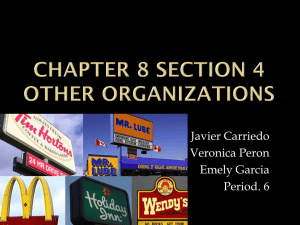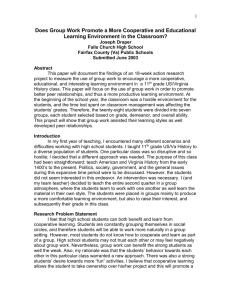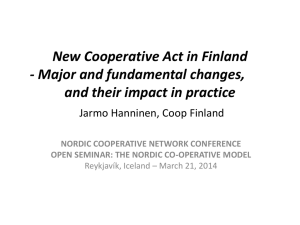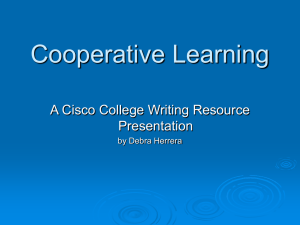The effects of cooperative learning on junior high school students
advertisement
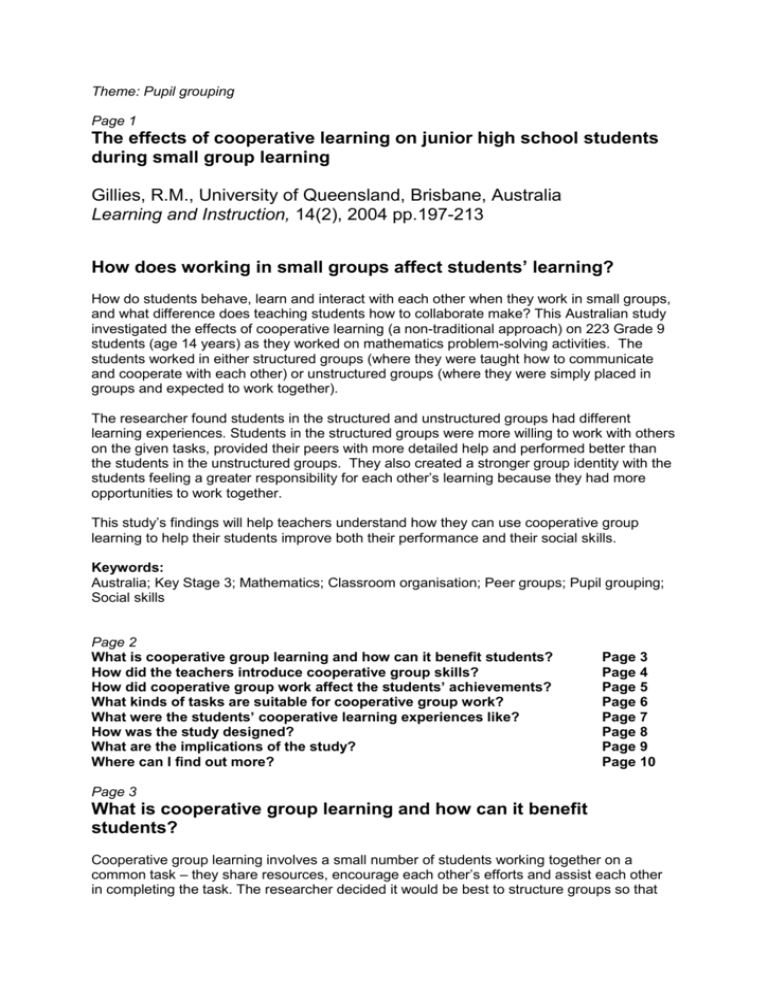
Theme: Pupil grouping Page 1 The effects of cooperative learning on junior high school students during small group learning Gillies, R.M., University of Queensland, Brisbane, Australia Learning and Instruction, 14(2), 2004 pp.197-213 How does working in small groups affect students’ learning? How do students behave, learn and interact with each other when they work in small groups, and what difference does teaching students how to collaborate make? This Australian study investigated the effects of cooperative learning (a non-traditional approach) on 223 Grade 9 students (age 14 years) as they worked on mathematics problem-solving activities. The students worked in either structured groups (where they were taught how to communicate and cooperate with each other) or unstructured groups (where they were simply placed in groups and expected to work together). The researcher found students in the structured and unstructured groups had different learning experiences. Students in the structured groups were more willing to work with others on the given tasks, provided their peers with more detailed help and performed better than the students in the unstructured groups. They also created a stronger group identity with the students feeling a greater responsibility for each other’s learning because they had more opportunities to work together. This study’s findings will help teachers understand how they can use cooperative group learning to help their students improve both their performance and their social skills. Keywords: Australia; Key Stage 3; Mathematics; Classroom organisation; Peer groups; Pupil grouping; Social skills Page 2 What is cooperative group learning and how can it benefit students? How did the teachers introduce cooperative group skills? How did cooperative group work affect the students’ achievements? What kinds of tasks are suitable for cooperative group work? What were the students’ cooperative learning experiences like? How was the study designed? What are the implications of the study? Where can I find out more? Page 3 Page 4 Page 5 Page 6 Page 7 Page 8 Page 9 Page 10 Page 3 What is cooperative group learning and how can it benefit students? Cooperative group learning involves a small number of students working together on a common task – they share resources, encourage each other’s efforts and assist each other in completing the task. The researcher decided it would be best to structure groups so that they comprised students of different achievement levels, in the light of research that suggests most students learn more in mixed-achievement groups. The researcher believed that, ideally, a group of four students would consist of one high-achieving student, two medium-achieving students and one low-achieving student. The researcher quoted previous research which found that cooperative learning had a number of potential benefits, such as students: feeling they are personally liked and that others care about their learning; feeling motivated to participate and achieve; learning different functions for language in thinking and reasoning than in teacher-led discussion; engaging in higher-order thinking skills; and being more aware than teachers of what other students do not understand and often providing explanations that are better than their teachers’ at clarifying their fellow students’ misconceptions. page 4 How did the teachers introduce cooperative group skills? Before asking the students to work cooperatively together on a unit of work, the teachers who organised the structured groups discussed with their classes what their students’ expectations were of each other for a successful group experience. The teachers recorded the students’ ideas on the white board and discussed the ideas with the class as a whole. The teachers then organised the ideas into a list of around five behaviours that the class agreed were important for successful small group work. Small group skills needed to promote successful cooperation included: actively listening to others; resolving conflicts democratically; sharing ideas and resources; providing constructive criticism when appropriate; and working with others to evaluate the group’s progress. (For example, ‘What have we accomplished? What do we still need to do? How are we going to manage that?) page 5 How did cooperative group work affect the students’ achievements? The researcher found the students in the structured groups (where students were taught how to collaborate with each other and worked regularly in groups) were more willing to help and promote each other’s learning than the students in the unstructured groups (where students were simply placed in groups on an ‘ad hoc’ basis and expected to work together). In the structured groups, students: worked with others on the task; shared ideas and information; asked each other to elaborate on their points; and listened to each other. Students in the structured groups demonstrated fewer non-cooperative behaviours and fewer off-task behaviours than their peers in the unstructured groups. They also perceived the other students in their group as less likely to: interrupt and cut each other off; and try to dominate others. The students in the structured groups used more higher order thinking skills to respond to specific problem-solving questions and attained higher scores on the mathematics questionnaire (mean score = 2.07) than their peers in the unstructured groups (mean score = 1.63). Page 6 What kinds of tasks are suitable for cooperative group work? The study suggested that tasks suitable for group work are open-ended and discovery based (i.e. with no set answers). Such tasks require students to share ideas and information in order to find creative solutions or to discover underlying principles to the problem that they are working on. For example, in the study, the group problem-solving activities were based on a unit of geometry. Teachers expected students to carry out activities in the following sequence: work out the total size of the internal angles of different plane shapes (e.g. triangle, square etc); use this information and their knowledge of the number of sides each plane shape had, to see if they could predict the total size of the internal angles of an octagon, a decagon and a shape with n = 21 sides or any given number for n; write a formula to solve a specific problem of finding out how many edges a rhombicosidodecahedron has (a shape that has 62 faces); and calculate the number of edges in any given solid shape given the number of faces. The activities were designed to encourage students to draw on, synthesise and integrate their previous knowledge. In the above example, the second activity built on the first. The students had to apply their understanding to develop a formula to help them solve a different problem. The students were expected to analyse their solutions through probing questions. Page 7 What were the students’ cooperative learning experiences like? The study found that students in the structured groups gave each other more detailed and timely explanations of how to solve the problem than the students in the unstructured groups. Students in the unstructured groups gave more short responses that provided little information to facilitate understanding and learning. The explanations provided by students in the structured groups were given both in response to specific requests for help and when the students thought the others in the group needed help or support. For example: ‘If we place the angles like this (pointing to the shapes being manipulated), we can work out the degrees (angle size). Then if we add these ones – we should be able to get them all (meaning the total for the internal angles of the pentagon) – we get it (meaning the answer). What do you think? (Directed at other group members).’ The researcher suggested that the willingness of the students in the structured groups to help each other succeed with the task, combined with their reluctance to interrupt or disrupt each other as they worked, created a strong sense of group identity and an environment conducive to learning. Their interactions contributed to the shared thinking and the coconstruction of meaning that occurred as group members discussed the feasibility of suggestions, tested them out, disputed hypotheses and then agreed on final responses. Their capacity to engage in persistent and systematic inquiry during the group activities was pivotal to the learning that occurred. Page 8 How was the study designed? The study involved 223 Grade 9 students (99 in structured groups, 124 in unstructured groups) from six schools in Brisbane, Australia. Three of the schools displayed a high commitment to cooperative group learning (by, for example, encouraging their staff to participate in professional development activities designed to broaden their understanding of the approach) and already structured their groups; the other three schools displayed a low commitment and their groups were unstructured. Students worked in groups of three or four – each group was of mixed gender, and had a mix of high, medium and low achievers. The students were videotaped as they took part in group-problem solving activities based on a unit of geometry. The researcher devised two observation schedules to code the students’ behaviour and their verbal interactions. The occurrence of behaviour within each category was recorded at ten second intervals for group members over ten minutes, with fifteen observations for each member. Two observers, who were unaware of the purposes of the study, coded the same six hours of videotape. The students were also given two questionnaires: a mathematics questionnaire designed and marked by two mathematics teachers, to find out how the students were constructing understandings and making links between information they discussed in the group activities. The students were given scores out of six (1 = basic recall of fact; 6 = evaluative response); and a questionnaire with fifteen items covering five key elements of successful group cooperation designed to measure students’ perceptions of how group members worked in their small groups. Page 9 What are the implications of the study for practitioners? In completing this digest, the authors began to ask questions about implications for practitioners. School leaders wanting to promote cooperative learning may like to consider the following questions. Could you do more to: encourage your staff to participate in professional development activities aimed at structuring small-group work and/or supporting the development of interpersonal and small group skills and the capacity of students to resolve conflicts as they go along? encourage and support staff to set up cooperative group learning experiences frequently and regularly? Teachers wanting to create more opportunities for cooperative group learning may wish to consider the following questions: do some of the students you teach seem to compete against, rather than collaborate with, other students? Could you do more to encourage them to work with their peers, by for example, giving feedback on how to give and receive help, or training students to provide detailed explanations? would it help you to share ideas with others in your department on designing openended, discovery tasks for which students will need to work together to find solutions? are there some specific areas of your subject which might be particularly suitable for cooperative group learning, such as a history investigation or a maths problem, in which you could try out cooperative learning on a small scale? would strategies such as odd one out (Click to http://www.standards.dfes.gov.uk/thinkingskills/casestudies/567267?view=get) or mysteries promote learning strategies that call for and encourage cooperative learning? Page 10 Where can I find out more? An ERIC digest, ‘The Essential Elements of Cooperative Learning in the Classroom’ can be found at: http://www.ericfacility.net/ericdigests/ed370881.html A comprehensive workshop on the theme of cooperative learning, including detail of the theory behind the approach, examples of classroom practice and resources, is available at: http://www.thirteen.org/edonline/concept2class/month5/index.html For some suggestions for improving learning within a cooperative framework and how to avoid some common mistakes, see: http://tlt.suny.edu/mistakes.htm A range of cooperative learning materials for teachers of modern languages can be found at: http://www.geocities.com/Paris/LeftBank/3852/cooplearn.html Cooperative science activities can be found at: http://www.schoolmission.net/SCHOOLHOUSE/sciact.html A systematic review of the use of small-group discussions in science teaching with students aged 11-18, and their effects on students' understanding in science or attitude to science can be accessed from: http://eppi.ioe.ac.uk/EPPIWeb/home.aspx?page=/reel/review_groups/science/review_one.ht m


